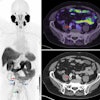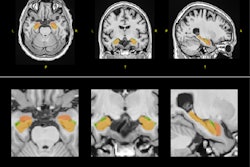PET imaging has revealed brain pathology linked to faster clinical progression of Alzheimer’s disease in patients with ApoE4 gene variants, according to a study published on 6 November in JAMA Neurology.
Based on PET scans from patients enrolled in previous studies, researchers found that ApoE4 carriers showed an acceleration of amyloid-mediated tau spreading compared with ApoE4 noncarriers. The study provides evidence that these patients may benefit from earlier treatments, suggested lead author Anna Steward, of Ludwig Maximilian University of Munich, and colleagues.
“The timing of therapeutic windows in anti-amyloid therapies may need special consideration in ApoE4 carriers compared to noncarriers to successfully attenuate tau spreading,” the group wrote.
In Alzheimer's disease, beta-amyloid deposits are thought to initiate the spreading of neurofibrillary tau tangles in specific cortical regions, which is believed to drive neurodegeneration and cognitive decline. Thus, drugs that target beta-amyloid should ideally be applied at low tau levels to inhibit this “cascade” and slow tau-related neurodegeneration, according to the group.
Carriage of the ApoE4 allele is the strongest known risk factor for sporadic Alzheimer’s disease, yet it is unclear whether or not this genetic variant causes tau spreading at lower beta-amyloid levels than other patients, the researchers added.
“It is therefore crucial to determine [beta-amyloid] thresholds at which tau spreading is triggered to potentially inform treatment decisions,” they noted.
To that end, the researchers analyzed images from 367 patients in two previous clinical diagnostic studies who had baseline PET scans and then follow-up scans after 1.9 and 1.4 years. A total of 152 individuals were ApoE4 carriers, and these patients were significantly younger with a higher number meeting standard beta-amyloid PET “positivity thresholds,” the researchers noted.
The study’s main outcome was interactions observed in brain regions between ApoE4 status and beta-amyloid levels with annual tau PET increases. Tau accumulation was calculated using “centiloids,” which indicate uptake of tau protein PET radiotracer (F-18 flortaucipir, for instance) in affected regions on a scale of 0 to 100.
According to the analysis, the researchers found that beta-amyloid-related tau spreading trajectories diverged around 12 to 15 centiloids between ApoE4 carriers and noncarriers, but below the typical 26-centiloid cutoff for amyloid PET positivity.
“This indicates that tau spreading may be triggered earlier in ApoE4 carriers and therefore may be beneficial to explore disease-modifying anti-Aβ treatments at lower Aβ levels,” the group wrote.
Ultimately, at this stage, the results have implications for clinical trial designs by illustrating that ApoE4 carriers may require earlier intervention to effectively attenuate tau spreading and associated clinical deterioration, the authors noted.
“Our results motivate further research into Aβ thresholds that determine clinical trial inclusion according to patient-specific characteristics, such as ApoE4, so that AD progression can be targeted in time to prevent tau spreading,” the researchers concluded.
A link to the full article can be found here. The study authors included scientists at Eli Lilly and Company.




















